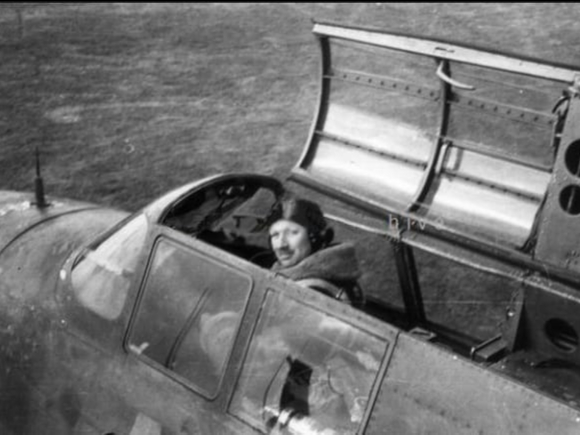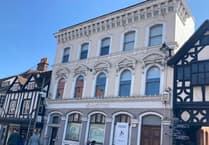Mick Bradford writes this week to remind us of a sad anniversary that passed on September 22.
He recalls the night an experimental Douglas Boston aircraft crashed in Shottermill with the loss of three lives in 1942. The aircraft had been modified with a huge searchlight fitted in the nose to aid night fighters to spot enemy bombers engaged in the Blitz but encountered engine trouble over Hindhead.
The Last Sortie of Douglas Boston III, AL470 from 534 Squadron, Tangmere, Sussex
“HELLO WODAN RED 2. WODAN RED 1 HERE, READY FOR INTERCEPT: DIVERGE, REPEAT, DIVERGE.”
The voice was that of Flying Officer Michael Winter, making a radio call to the Hurricane IIc fighter flying alongside his twin-engined Douglas Boston III, AL470 of 534 Squadron. It was September 22, 1942. The pair had taken off from Tangmere at 5.40pm for Airborne Interception practice (AI). This was to test the radar system in the aircraft by using the Hurricane as the target, in preparation for an operational patrol later that night.
The process normally took about half an hour, receiving general vectors from Ground Control at Durrington and converging vectors from his radar operator who was seated in the back of the Boston. This was Flight Sergeant Wilfred ‘Jimmy’ Cleall, whose job was staring at a tiny screen behind a padded visor interpreting returns from the target, which he passed on to the pilot as directions. The two were a dedicated team and always flew operations together.
In three minutes they had reached their practice height of 10,000 ft. There was a broken layer of cloud over Tangmere and the coast, but it was more solid to the north. RED 2, the Hurricane pilot, who was also the Flight Commander for the practice, responded: “HELLO RED 1, RED 2 HERE. NEGATIVE. REPEAT, NEGATIVE. ENGINE OVERHEATING AFTER THE CLIMB. GOING BACK TO MOTHER [code for Base]. SUGGEST YOU DO THE SAME. OUT.” With that, he gave a salute-like wave, peeled off and rolled into a downward dive, disappearing into the patchy cloud below. Underneath, a cold grey sea lashed white breakers against the Bognor shoreline.
Michael called Ground Control: “HELLO CONTROL. RED ONE HERE: RED TWO US. ANY TRADE FOR ME?” “HELLO RED ONE, CONTROL HERE, NOTHING DOING I’M AFRAID.” Michael fumed. He had returned from nine days’ leave that very afternoon and felt he needed the practice. Jimmy had also been away for a similar time and was likely to be ‘rusty’ too.
His displeasure suddenly ceased. He had momentarily forgotten he had a passenger, lying on his stomach in the small compartment above and behind the pilot’s seat. This was his best friend, Pilot Officer John Lindley, also the squadron adjutant, who split his administration duties with RAF Ford, seven miles to the east. Michael often took John up with him and Jimmy on AI practice flights and dropped him off at Ford before returning to Tangmere.
John had no intercom, which meant the noise from the engines made any voice communication between them virtually impossible. Michael looked enquiringly over his shoulder and stuck up his thumb: a smiling John reciprocated. It was none-too warm at this altitude and Michael worried about him, but he was wearing his RAF greatcoat and didn’t seem to be complaining. In truth, John, a gentle soul and the kindest of men, was fascinated by the work they did, so he was happy to be there. In any case, he wasn’t officially on duty at Ford until eight, so there wasn’t a time problem.
Suddenly, Jimmy cut in on the intercom: “Skip! In your ten o’clock! Low! In and out of cloud! Blimey! It looks like a JU 88!” Michael wheeled the Boston round in the direction of the ‘Bogey’. (RAF code for an unidentified aircraft). “Let’s get after him Jimmy! Anything on the magic eye?” “Yes Skip, it’s strong! Stay on this heading!” Michael reigned in his excitement; if it was an enemy aircraft he’d better not get too close as the Boston was unarmed. “Good work Jimmy! Control must be asleep! We’ll just chase him for a few miles. I’ll stay higher and keep back; see if you can keep tabs on him!”
Michael descended towards the cloud layer but his intention was to keep out of it as the Turbinlite Boston, due to its flat searchlight nose and heavy load of batteries, was extremely difficult to manoeuvre on instruments. He turned to the prone passenger behind him and held up five fingers, indicating five minutes. A smile and an upward thumb acknowledged it was okay.
“He’s pulling away Skip,” cried Jimmy. “Faster!” In normal circumstances, Michael would have put the nose down to speed up, but the cloud layer, now solid, was only a few hundred feet below. Determined to avoid going into it, he did the only thing available to him; he opened up the throttles and increased the RPM. The speed started to build, but Jimmy kept calling, “Faster! Faster!”
Concentrating hard, he ramped up the power further. What the devil were they following? He looked at his watch: 17.50. Strange; the dial was blurred! So were the instruments!! His eyes were fine; he could see the clouds and the horizon clearly. The penny dropped! It was engine vibration and it went right through the airframe! He reset the RPM, throttled back, and decided it was perhaps time to go home, giving John a hitch-hiker’s thumb signal over the shoulder. The shaken passenger nodded in approval; the vibration had been most disconcerting! Michael flicked the intercom switch: “We’re going home Jimmy!”
“Thank god for that!”, came the voice from the rear cockpit. “I couldn’t make out a thing on the display! It’s all gone haywire!”
Michael banked the Boston to bring it round on to a southerly heading. Suddenly, the aircraft started diving, picking up speed rapidly. He pulled back on the yoke, but it wouldn’t budge. His mind raced. What on earth could be wrong? Then the cloud bank enveloped them.
Inspiration: he tried the trimmer. It was working and the dive shallowed out a little. Could he use it to level the aircraft back up? The trimmer was powerful but over-using it could result in an overstressed airframe. As there was no alternative, he nervously continued as the speed increased further.
Jimmy called out urgently on the intercom. “One of the boxes Skip!” (seven radar boxes were crammed into the tiny space underneath his display) “It’s come loose! I can see it! It’s jamming the control wires! I think I can free it.” He had to loosen his harness to reach the box. “Got it Skip!” He was obviously struggling and tried to free it with the help of his boot: “Just.. pulling it.”
The effect of Jimmy freeing the jammed cable was about as dramatic as it was possible to get. The diving Boston came out of cloud only a few hundred feet above the terrain below. Now, with the elevator control free and the trimmer wound fully back, the aircraft shot violently upwards like a rocket, the resultant G force causing all three occupants to black out.
Up, up it went through the cloud layer into a full loop; nine and a half tons of aircraft. At the top of the loop, the G disappeared and Michael regained consciousness. The Boston was now pointing downhill again, ready to repeat the manoeuvre, but he reacted swiftly to get it under control; the last thing he needed was a spin, which in a Boston was fatal!
Flying completely blind, and using every ounce of his flying skills, he wound the trim forward, at the same time leaning with all his weight on the control column to prevent another skyward excursion. After what seemed like an age he felt the pressure on the yoke easing, and this gave him hope he would come out of the cloud at a shallow enough angle to recover. “Fire in the back here Skip!” The detached cables from the disconnected box were arcing and sparking! “My watch! My watch!” cried Jimmy (it was a present from his mother). “It’s come off!” Michael heard him, but was too busy to answer.
The Boston broke cloud for the last time – four hundred feet above Hindhead Common. Michael winced. They were doomed; he would never pull out in time. But wait. There was a valley. He could see the ground falling away between two ridges. It was his only chance and he went for it. The valley slope was just enough to keep the aircraft from smashing into the ground. Brushing tree tops and skimming the roofs of houses on the way down, Michael finally felt the Boston levelling off. There was a built up area ahead and he realised he now needed to apply power or he would mush straight into it. If he could do that, they would be saved. He swiftly opened the throttles to full power and instantly the vibration came back again, this time more vigorously.
Encouragingly however, the aircraft flattened out – one hundred feet above Shottermill School. At least it was under control; soon it would be climbing away and in no time at all, they should be safely back home at Tangmere – Phew!
But it was not to be. At that precise moment, Michael Winter’s luck finally ran out. With an almighty sickening bang, the starboard engine, its propeller turning at full power, tore away from its mountings and precessed leftwards, forwards and upwards, carving its way through the cockpit. Streaming vapour, it shot through the air like a naval shell, going on to fall through the roof of the Rex Cinema in Shottermill.
The sudden loss of the engine, combined with the stresses on the airframe in recovering from the dive, had caused the aircraft’s structure to fail. The Boston broke up over the grounds of Holy Cross Hospital (now Priors Wood estate) and what was left of the fuselage, containing Michael, Jimmy and John, fell onto the Hindhead Road near the Shottermill Club, where the controlled crossing is today. All three were killed in the crash.
Postscript
In his report of the accident, Vernon Brown, Chief Inspector of the Air Ministry’s Accidents Investigation Branch, concluded: “The cause of the accident was the breaking away of the starboard engine – one of the bearers of which was defective – during high stressing by the pilot of the aircraft whilst recovering from a dive out of cloud.
“The sudden loss of weight forward and the consequent violent change of direction in the aircraft’s flight path resulted in complete collapse of the aircraft structure.”
The defect he mentioned was in the upper outboard engine bearer, part of the starboard engine mounting, and was in fact a fracture, caused by severe local overheating. This was due to regular electrode clamping on the bearer, a practice almost certainly employed for the purpose of charging the 48 Tunbinlite batteries.
Several months later, it was discovered that there was a critical RPM range that had to be avoided in the Boston at all costs, as severe damage could result. This was rectified in later versions, as was the practice of running control cables through the rear cockpit.
The Turbinlite programme was abandoned three months after this incident. Conceived in the dark, desperate days of 1940, it held the line until better aircraft and equipment came along. Viewed in hindsight, it was a failure, almost a crackpot one; yet, for all its shortcomings, it provided crews with invaluable and indispensable experience, which eventually would win the war for the Allies in the night skies over Germany.
The crews realised that they were being used as reserves, but they carried on, because it was their duty; and above all they wanted to be the best at their jobs. The three men in AL470 were all volunteers and joined via the RAF VR scheme.
Michael Winter, 22, joined the RAF straight from college and was an outstanding pilot. Jimmy Cleall, 27, a pre-war insurance agent, was regarded as one of the best Radar ‘Ops’ in the unit, and John Lindley, 34, gave up a top job with the Midland Bank simply because he wanted to ‘Do his bit’.
They were all friends and died together. Lamentably, there were many such accidents in the Turbinlite squadrons, and each one provided many valuable lessons for the future.
It is such a pity that three decent young men had to die seemingly so needlessly, but without question, the lessons learned from their tragic last sortie saved many more lives in the remaining years of the war.
The first person to arrive at the scene was 16-year-old Haslemere Army Cadet Don Hill. Given various clearing up duties by his captain, he found, lying very near the wreckage, a man’s wrist watch: the time had stopped at nine minutes to six.
Mick’s photograph gives an impression of what the Boston’s last moments would have looked like as it broke through the low cloud over Shottermill. Others show the small Boston cockpit with the tiny space behind in which John Lindley was cramped and pilot Michael Winter who so nearly managed to bring the Boston ‘home’.





Comments
This article has no comments yet. Be the first to leave a comment.